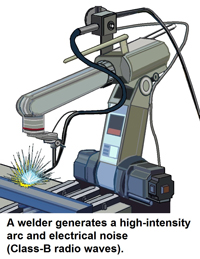
Highly Resilient System
FUJIMI
Non-Stop Microcomputer System
New Technology to handle disruptions in microcomputers
Microcomputers/controllers have been used in many applications, such as home appliances, office automation, networks, smart phones, automobiles and robots, and have become central to our daily lives. However, a microcomputer/controller has a unique problem: it can appear to fail (freeze) without being permanently damaged. This is similar to a person’s fainting. He or she is not dead, and can be revived by several procedures including a mild shock. This problem with microcontrollers is well known to engineers, since it appears in many application areas.
【Examples from everyday life】

You have probably experienced these problems:
- A modem could not connect to the Internet, or a router was out of operation.
- Can be caused by lightning-induced surges and ESD (Electrostatic Discharge). - A smart phone could not respond or it became very hot.
- Can be caused by ESD. - A lift (elevator) did not stop at the desired floor, or the door of a lift opened while it was moving.
- Can be caused by electrical noise from the electric motor. - An air conditioner did not cool.
- Can be caused by power line noise. - A control in your automobile malfunctioned.
- Can be caused by radiation from a police radar or the electric field from nearby lightning.
The causes given above are among the most common; these problems can have other causes as well.
In a factory or an outdoor facility:


- Measurement equipment gave readings out of range or stopped measuring
- Can be caused by nearby lightning, or ESD intrusion. - A robot behaved strangely or stopped operating.
- Can be caused by electric arcs from a nearby welder. - An automated production line made defective products, or halted.
- Can be caused by surge voltage on the power line or ESD from a belt conveyer. - A home thermostat ignores its set temperature.
- Can be caused by nearby lightning, or surges on the power line.
The causes given above are among the most common; these problems can have other causes as well.
The examples above, both from daily life and industry, can usually be solved if you can power the device off and on once; then the malfunction will be cleared and functioning returned to normal. These types of problems occur in almost all microcomputers/controllers, and we use terms such as “freeze”, “disruption”, “violation” and so on. However, these are not real failures of the microcomputer/controller since it was not permanently damaged. They are temporary abnormalities in operation of a microcomputer. (Of course occasionally, in rare cases, there are real permanent hardware failures).
Causes of the problem
One of the root causes of the above problems is an electrical signal (noise) beyond the limited operating voltage range of the microcomputer/controller. Once such high voltages enter a microcomputer/controller, it cannot operate as expected since it is fabricated from a semiconductor, which has many very stringent operating limitations.
What are these electrical noise signals? The most common one is ESD (Electro Static Discharge). There are many other noise sources, such as nearby lightning, power transients from stepping motors and solenoids, radio frequency interference (RFI), and electromagnetic pulse (EMP) disturbances.

Electrostatic charges are easy to generate when the air is very dry. In the winter, when you put your sweater on, you can see small sparks and hear the crackle of static. Even these small sparks can have a voltage of several thousand volts (KV). Your body can even hold an electrostatic charge of over 10KV.
When this high voltage ESD reaches a microcomputer, a microcomputer designed to operate at only a few volts, normally 3V to 5V, it is to be expected that the microcomputer halts or operates abnormally. The good thing is, usually the energy content of such ESD is quite small and cannot permanently damage the microcomputer itself.
When you pick your smartphone up from the desk, if your body is holding a large electrostatic charge ( from walking across a carpet, perhaps), there can be a small electric arc from your finger to the smartphone, and the smartphone may malfunction, with a frozen screen or no response to the keys. In the worst case, the smartphone may become very hot.
An internet modem and router are connected by copper wires to their power sources and Ethernet connections. These power lines and Ethernet signal lines can act as antennas for electromagnetic pulses caused by lightning. If this noise enters the equipment, it can easily cause a freeze.
>>>Download:FUJIMI-Flyer
What are the root causes of these disturbances?
- ESD (Electrostatic Discharge)
- Electrostatic charges are everywhere and the human body is a good container. In a dry area, electrostatic voltages may easily exceed several KV. If this high electrostatic voltage enters a microcomputer, it will cause a fault.
- Lightning
- The voltage difference in a lightning strike may exceed a million volts and thus, it is difficult to estimate where and how it causes effects. If it is too near, of course permanent damage can occur.
- Radio Waves
- In the case of Radar transmissions, the frequency may be quite high, in the GHz range. For strong pulses, it is difficult to estimate what effects or problems might be caused.
- Arcs
- An AC motor, or an AC solenoid, is often driven by a relay. At the relay contacts, there can be arcing when the power is switched on and off. These arcs generate radio frequency noise, called B-class radio waves. This B-class radiated noise can be transferred on the power line through the microcomputer’s power supply.
- Reverse voltage from a coil
- When a motor or solenoid is switched off, the magnetic energy held in its coil generates a high voltage surge. This high voltage surge also can be transferred on the power line and affect a microcomputer.
- Arcs from welding
- An electric arc welder concentrates electrical energy on one spot to heat and weld the metal. The concentrated energy from the arc is radiated into the environment and if it enters a microcomputer, it may cause a fault.
These noise sources from outside a microcontroller /computer are not predictable nor easily modeled in waveform, timing and amplitude, since these originate from random events in nature or high power electrical machinery.
Traditional Protection
These problems are well known to architects and designers of microcomputer systems, who apply several types of protection.
However, this problem still exists. Many types of equipment, machines, home appliances and modems/routers are downed by such malfunctions. There are limits to the effectiveness of such protection, but there is neither logic nor limitation of ESD, lightning strikes, and other high voltage noise sources, with regard to level or to timing. As a result, there is no complete protection.
At Present
A microcomputer is a type of computer. In a normal computer, there is only one active component, equivalent to the brain of a human. This computer brain is called the “Central Processing Unit” (CPU). This CPU reads the program instructions, and according to the instructions, it processes, modifies and transfers data. Once some noise, such as ESD, enters a microcomputer, one possible effect is that the CPU loses track of which instruction must be read next in the long sequence of instructions in a program. Then, the CPU may do something crazy – or nothing at all.
This is one root cause of the problem. And there is only one completely reliable method to restore the CPU to normal operation. This method is called a “reset” and when power is first turned on, this reset is sent to all of a computer’s components. Once this reset is given to a malfunctioning CPU, the CPU (Brain) can resume normal operations and the total system operation also can return to normal.
